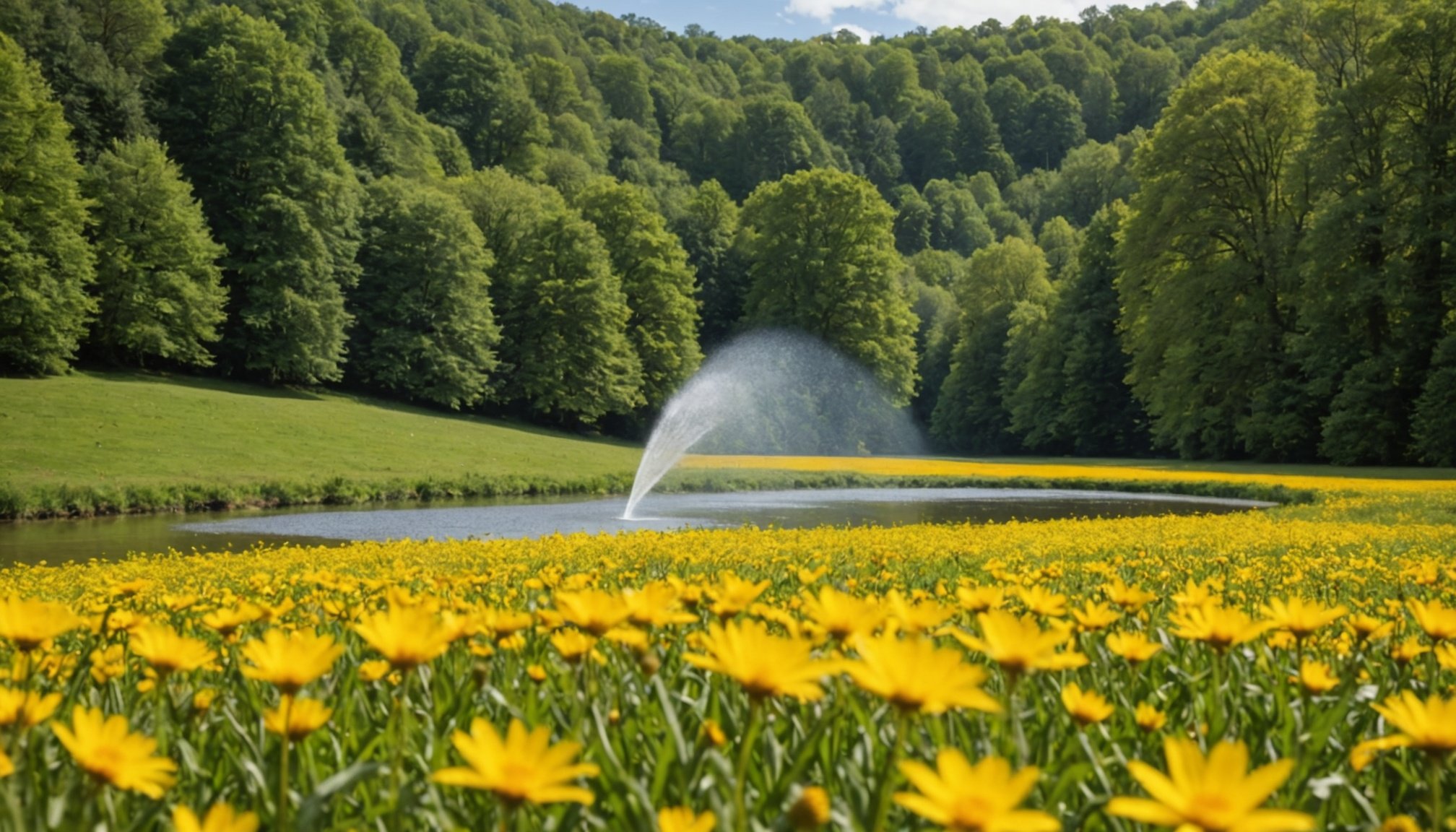Understanding the Impact of Pollen on Water Clarity
Pollen effects on water clarity can be profound, especially during the vibrant UK pollen season. Pollen originates from various sources, including trees like birch and oak, grasses, and weeds. Each of these sources releases different types of pollen particles into the air, which can eventually settle into water bodies.
Once pollen lands in water systems, it can cloud the clarity. In pools and spas, pollen mixes with chlorine, breaking down into deeper colours, forming a film that diminishes water’s pristine look. Natural bodies of water aren’t spared either. Lakes and rivers can also experience decreased water visibility as pollen introduces organic particles. These particles foster the growth of algae and bacteria, further exacerbating reduction in water clarity.
Avez-vous vu cela : Essential Guide: How Frequently Should You Monitor Water Quality in Your UK Home Swimming Pool?
The UK pollen season varies significantly, typically starting around late winter and extending into late summer, depending on regional climates. For instance, southern regions might experience earlier and more intense pollen levels compared to northern areas, influencing the extent to which water systems are affected.
Understanding these pollen effects during the specific timelines of the UK pollen season is key to managing water clarity efficiently, ensuring proper maintenance and filtration systems are in place to counteract these environmental challenges.
En parallèle : Crafting an Organic Oasis: Designing a Pool That Harmonizes with the UK Countryside
Preventative Measures for Maintaining Water Clarity
Maintaining water clarity is essential for both aesthetic and hygienic purposes. One effective approach is implementing preventative techniques to combat issues such as pollen accumulation. Regular removal of surface debris is crucial in this process. Debris not only includes leaves and insects but also pollen, which can cloud the water and promote algae growth. Utilizing a skimmer or surface net on a daily basis helps keep the water pristine and inviting.
During high pollen periods, the use of covers for pools and spas becomes significantly important. These covers act as barriers, preventing pollen from settling on the water’s surface. This simple preventative measure can greatly reduce the time and effort required for subsequent water maintenance.
Scheduling routine cleanings and professional maintenance is another key aspect of ensuring crystal-clear water. Regular sessions can help address build-ups before they become more challenging issues, thus preserving water clarity and the functional integrity of the pool or spa.
By incorporating these strategies—routine debris removal, using covers, and maintaining a cleaning schedule—owners can effectively manage water quality and enjoy their aquatic amenities with minimal hassle. These simple actions are palatable solutions that keep your water clean and welcoming for swimmers year-round.
Effective Chemical Treatments for Clear Water
To achieve and maintain pristine water, chemical treatments are vital elements in every toolkit. These treatments make short work of impurities and unwanted particles, bringing clarity and safety to your water.
Best Chemical Products for Pollen Season
During pollen season, opting for specialized water chemicals can dramatically improve water clarity. Algaecides, for instance, are known to effectively reduce pollen particles. Additionally, clarifiers form a crucial part of your arsenal, binding small particles together so they can be easily filtered out. These solutions cater specifically to the challenging conditions spring pollen presents, making them indispensable in maintaining a crystal environment.
Balancing pH Levels and Water Chemistry
A balanced pH level ensures that other water treatment solutions work effectively. Optimal water chemistry revolves around stabilizing pH and Total Alkalinity levels. Products such as pH increasers or decreasers and alkalinity boosters assist in maintaining these crucial parameters. Proper balance not only enhances clarity but also safeguards against equipment damage and skin irritation.
Shock Treatments and Their Timing
Shock treatments are potent clarification techniques tailored for sudden clarity setbacks. Administered typically once a week or more during heavy use, shocking involves adding a high dose of sanitizing chemicals. These treatments are invaluable post-storm or during algae blooms, effectively breaking down contaminants and swiftly restoring water to its sparkling best.
Recommended Equipment for Water Clarity Management
Water clarity is essential for an enjoyable swimming experience, especially during high pollen seasons when the pool or spa may become more susceptible to debris accumulation. Effective water filtration systems play a crucial role in maintaining crystal-clear water. They help trap and remove impurities, ensuring that your pool remains inviting and safe. Without robust filtration, pollen and small particles can quickly cloud the water, leading to frequent maintenance.
To complement your filtration system, consider investing in high-quality pool and spa vacuums. These devices efficiently remove debris from the pool floor and other hard-to-reach areas. Skimmers are also essential, capturing floating leaves and larger particles before they sink and complicate clarity maintenance.
Further enhancing your setup, the installation of additional equipment like separators and clarifiers can be beneficial. These tools work to remove the smallest of suspended particles and prevent them from settling. Separators draw on advanced technology to divide particulates from the water, while clarifiers coagulate tiny particles, making them easier for the filtration system to capture.
By equipping your pool with these recommendations, you establish a comprehensive water clarity strategy that minimizes maintenance efforts and maximizes enjoyment.
Safety Considerations Amidst Pollen Season
Navigating through pollen season safely requires some vigilance, particularly when it comes to water health and managing pollen allergies. Pollen can trigger allergic reactions, and during peak pollen days, it is crucial to address its presence, even in swimming pools and spas.
Begin by being mindful that pollen can settle on the surface of water bodies. This can worsen allergies for those susceptible, making it essential to monitor and maintain good water quality. Since pollen can interact with water, testing the water regularly is advised. Testing kits are invaluable tools here, assessing the water for unwanted contaminants promptly and helping manage allergens effectively by ensuring that chemical levels remain balanced.
Safety tips for swimming and using spa facilities during high pollen days are indispensable. Closing pool covers when not in use and cleaning the water surface regularly can mitigate pollen accumulation. Additionally, those with severe pollen allergies should avoid swimming or using spa facilities during peak pollen hours. Special attention should be given to the maintenance and cleanliness of filtration systems, as these are pivotal in keeping both outdoor and indoor water spaces safe.
By implementing these guidelines consistently, individuals can enjoy water activities while effectively managing the effects of pollen.
Regional Specifics for Pollen Management in the UK
Understanding regional advice for pollen management is essential to effectively tackle allergies throughout the UK. Pollen forecasts can be an invaluable tool in predicting and managing exposure levels. These forecasts provide insights into different pollen types prevalent in various regions, guiding residents toward suitable management practices.
The UK’s diverse climate means that pollen management requires a tailored approach. Each region may experience varying pollen concentration levels due to distinct environmental factors. For example, southern areas might contend more with grass pollen, while northern regions could experience tree pollen peaks. By localising these forecasts, residents can adopt strategies that are most beneficial to their needs.
Local guidelines offer structured assistance, suggesting practical measures to be undertaken during high pollen seasons. Taking advantage of such guidelines ensures communities are prepared and responsive to changes in pollen levels. Ensuring connectivity with these resources ensures individuals are updated on effective management policies.
For ongoing pollen management advice, it’s beneficial to connect with local resources. Local health boards and specialised weather services often provide updates and recommendations. Engaging with these dedicated sources not only helps in strategising preventive steps but also enables the public to make informed decisions about their health and daily activities.











